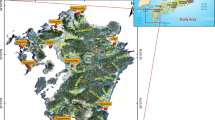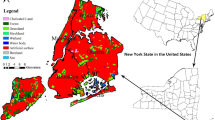Abstract
Flash flood often causes serious losses in small catchments of China. Nevertheless, the flash flood vulnerability assessment is relatively limited in China. This paper presented a material flow assessment framework to evaluate the flash flood vulnerability for small catchments in Wuzhishan County of Hainan province, China. The framework was developed into three parts: selection of typical villages and small catchments, calculation of exposure, sensitivity and adaptive capacity with material flow analysis, and multiple evaluation of vulnerability with the proposed material flow indices. In this framework, all material flows of exposure, sensitivity, and adaptive capacity were measured by water’s mass. Then, the relationship between the three elements of vulnerability was established through material flow indices. Results of the three elements of vulnerability and four material flow indices in each small catchment were exhibited via GIS. The evaluation results suggested that catchments with lower exposure, sensitivity, and adaptive capacity did not necessarily lead to lower vulnerability, as the inherent relationship among them might aggravate the vulnerability of catchments to flash flood. Some suggestions were put forward for the prevention of flash flood based on the vulnerability assessment. Finally, the advantages and disadvantages of the approach were discussed.
















Similar content being viewed by others
References
Adger WN (2006) Vulnerability. Glob Environ Change 16(3):268–281
Binder CR, Hofer C, Wiek A, Scholz RW (2004) Transition towards improved regional wood flows by integrating material flux analysis and agent analysis: the case of Appenzell Ausserrhoden, Switzerland. Ecol Econ 49(1):1–17
Bradley MP, Smith ER (2004) Using science to assess environmental vulnerabilities. Environ Monit Assess 94(1–3):1–7
Brooks N, Adger WN, Kelly PM (2005) The determinants of vulnerability and adaptive capacity at the national level and the implications for adaptation. Glob Environ Change 15(2):151–163
Chang LF, Huang SL (2015) Assessing urban flooding vulnerability with an emergy approach. Landsc Urban Plan 143:11–24
Füssel HM (2007) Vulnerability: a generally applicable conceptual framework for climate change research. Glob Environ Change 17(2):155–167
Gallopín GC (2006) Linkages between vulnerability, resilience, and adaptive capacity. Glob Environ Change 16 (3):293–303
Gascón E, Laviola S, Merino A, Miglietta MM (2016) Analysis of a localized flash-flood event over the central mediterranean. Atmos Res 182:256–268
Gaume E, Bain V, Bernardara P, Newinger O, Barbuc M, Bateman A et al (2009) A compilation of data on european flash floods. J Hydrol 367(1):70–78
GLP (2005) Science plan and implementation strategy (IGBP Report No. 53/IHDP Report No. 19). GLP, Stockholm
Gunderson LH (2000) Ecological resilience - in theory and application. Annu Rev Ecol Syst 31(31):425–439
Gallopin GC, Gutman P, Maletta H (1989). Global impoverishment, sustainable development and the environment: a conceptual approach. Int Soc Sci J 41(3):375–397
Hapuarachchi HAP, Wang QJ, Pagano TC (2011) A review of advances in flash flood forecasting. Hydrol Process 25(18):2771–2784
IAHS-UNESCO-WMO (1974) (Ed.) Flash floods, proceedings of the Paris symposium, Sept 1974
Karagiorgos K, Heiser M, Thaler T, Hübl J, Fuchs S (2016) Micro-sized enterprises: vulnerability to flash floods. Nat Hazards 84(2):1091–1107
Kasperson JX, Kasperson RE, Turner BLI (2012) Vulnerability to global environmental change. Prog Hum Geogr 20(4):529–539
Llasatbotija M, Llasat MC, López L (2007) Natural hazards and the press in the western mediterranean region. Adv Geosci 12:81–85
Matthews E (2000) The weight of nations—material outflows from industrial economies. World Resources Institute, Washington
McCarthy JJ, Canziani OF, Leary NA, Dokken DJ, White KS (2001) Climate change 2001: impacts, adaptation and vulnerability. Cambridge University Press, London
Metzger MJ, Rounsevell MDA, Acosta-Michlik L, Leemans R, Schröter D (2006). The vulnerability of ecosystem services to land use change. Agr Ecosyst Environ 114(1):69–85
Newell B, Crumley CL, Hassan N, Lambin EF, Pahl-Wostl C, Underdal A et al (2005) A conceptual template for integrative human–environment research. Glob Environ Change 15(4):299–307
Ouma YO, Tateishi R (2014) Urban flood vulnerability and risk mapping using integrated multi-parametric AHP and GIS: methodological overview and case study assessment. Water 6(6):1515–1545
Rahman MT, Aldosary AS, Nahiduzzaman KM, Reza I (2016) Vulnerability of flash flooding in riyadh, Saudi Arabia. Nat Hazards 84(3):1–24
Roberts MG, Yang G (2003) The international progress of sustainable development research: a comparison of vulnerability analysis and the sustainable livelihoods approach. Prog Geogr 22(1):11–21
Szlafsztein C, Sterr H (2007) A GIS-based vulnerability assessment of coastal natural hazards, State of Pará, Brazil. J Coast Conserv 11(1):53–66
Timmerman P (1981) Vulnerability, resilience and the collapse of society: a review of models and possible climatic applications. Institute for Environmental Studies, University of Toronto, Toronto
Yucel I (2015) Assessment of a flash flood event using different precipitation datasets. Nat Hazards 79(3):1889–1911
Acknowledgements
The research was supported by National Natural Science Foundation of China (51509179, 51679159), National Key Research and Development Program of China (2016YFC0401903), Science Fund for Creative Research Groups of the National Natural Science Foundation of China (51621092) and Program of Introducing Talents of Discipline to Universities (B14012). The authors acknowledge the assistance of anonymous reviewers.
Author information
Authors and Affiliations
Corresponding author
Rights and permissions
About this article
Cite this article
Lian, J., Yang, W., Xu, K. et al. Flash flood vulnerability assessment for small catchments with a material flow approach. Nat Hazards 88, 699–719 (2017). https://doi.org/10.1007/s11069-017-2887-2
Received:
Accepted:
Published:
Issue Date:
DOI: https://doi.org/10.1007/s11069-017-2887-2




